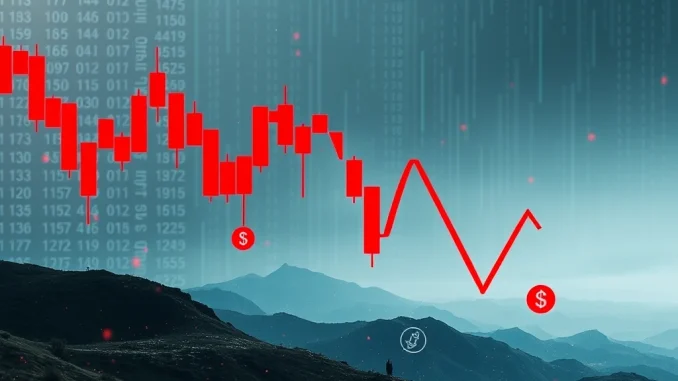
The cryptocurrency market just saw a significant jolt, with a staggering $110 million worth of crypto liquidation occurring in futures markets within the past hour alone. This sudden move adds to an already volatile 24 hours, which saw a total of $506 million in futures positions wiped out across major exchanges. For anyone involved in or watching the market, understanding these liquidation events is crucial.
What is Crypto Liquidation and Why Does it Matter?
At its core, crypto liquidation happens when a trader’s leveraged position is automatically closed by an exchange due to insufficient margin to cover potential losses. Traders use leverage in futures trading crypto to control a large position with a relatively small amount of capital. While this can amplify profits, it also significantly increases the risk of losing the initial capital, or margin.
When the market moves sharply against a leveraged position, the exchange forces the closure to prevent the trader’s balance from going below zero. This forced selling can create a cascading effect, pushing prices down further and triggering more liquidations, contributing to increased crypto market volatility.
Understanding the Scale: $110M in an Hour, $506M in 24 Hours
The fact that $110 million in liquidations occurred within a single hour highlights the speed and intensity of the recent market movement. While $506 million over 24 hours is a substantial figure, concentrated liquidations like the $110 million hour are often indicative of a particularly sharp and rapid price swing. This suggests that many traders with leveraged positions, particularly those betting on rising prices (long positions), were caught off guard by a sudden downturn.
While specific data on which cryptocurrencies were most affected is still emerging, significant market moves like this typically involve major assets. Bitcoin futures liquidation often accounts for a large portion of the total, given its market dominance and active futures market. Ethereum and other altcoins also contribute significantly to these figures.
How Does Leverage Trading Crypto Work?
Leverage trading crypto allows traders to borrow funds to increase their position size. For example, with 10x leverage, a trader can control $10,000 worth of crypto with only $1,000 of their own capital (margin). The potential profit on a 1% price increase is now based on $10,000, not $1,000. However, a 10% price *decrease* would wipe out the initial $1,000 margin, triggering liquidation.
Key aspects of leverage trading:
- Margin: The capital a trader puts up for a leveraged position.
- Leverage Ratio: The multiple of the trader’s margin that they are controlling (e.g., 5x, 10x, 50x).
- Liquidation Price: The specific price point at which the position will be automatically closed by the exchange. This price is determined by the leverage ratio and the margin level.
- Margin Call: Sometimes, exchanges issue a warning (margin call) before liquidation, giving the trader a chance to add more funds to their margin. However, in fast-moving markets, liquidation can happen instantly.
The recent liquidations indicate that many positions reached their liquidation price rapidly due to a swift price drop.
The Impact of Mass Liquidations on the Market
When a large number of positions are liquidated simultaneously, it creates selling pressure. The exchange is forced to sell the underlying asset to close the leveraged positions. This selling can drive the price down further, triggering *more* liquidations in a domino effect. This is a key mechanism that amplifies crypto market volatility during sharp price movements.
Large liquidation events are often seen as cleansing periods in the market, flushing out over-leveraged positions. However, they can be painful for individual traders involved and contribute to market instability in the short term.
What Can Traders Learn from This?
This event serves as a stark reminder of the risks associated with leverage trading crypto. While leverage can be powerful, it requires careful risk management.
Key takeaways:
- High Leverage, High Risk: Higher leverage ratios mean a smaller price movement against your position can lead to liquidation.
- Market Volatility: Crypto markets are inherently volatile. Sudden, unexpected moves can happen quickly.
- Risk Management: Using stop-loss orders and managing position sizes are crucial when using leverage. Do not risk more capital than you can afford to lose.
- Monitoring Data: Tracking liquidation data can provide insights into market sentiment and potential areas of support or resistance.
Conclusion: A Volatile Reminder
The sudden $110 million crypto liquidation in the past hour, part of a larger $506 million wipeout over 24 hours, underscores the inherent risks and significant crypto market volatility, particularly in the leveraged futures market. While Bitcoin futures liquidation and other altcoin liquidations are a normal part of these markets, events of this magnitude serve as a potent reminder for traders to exercise caution, manage leverage responsibly, and be prepared for rapid price swings.



